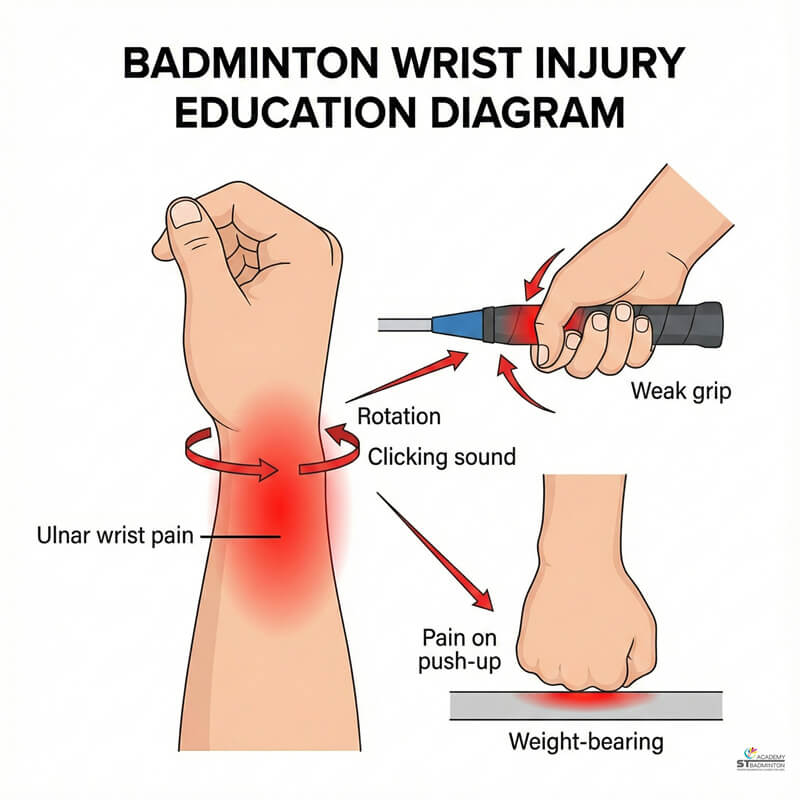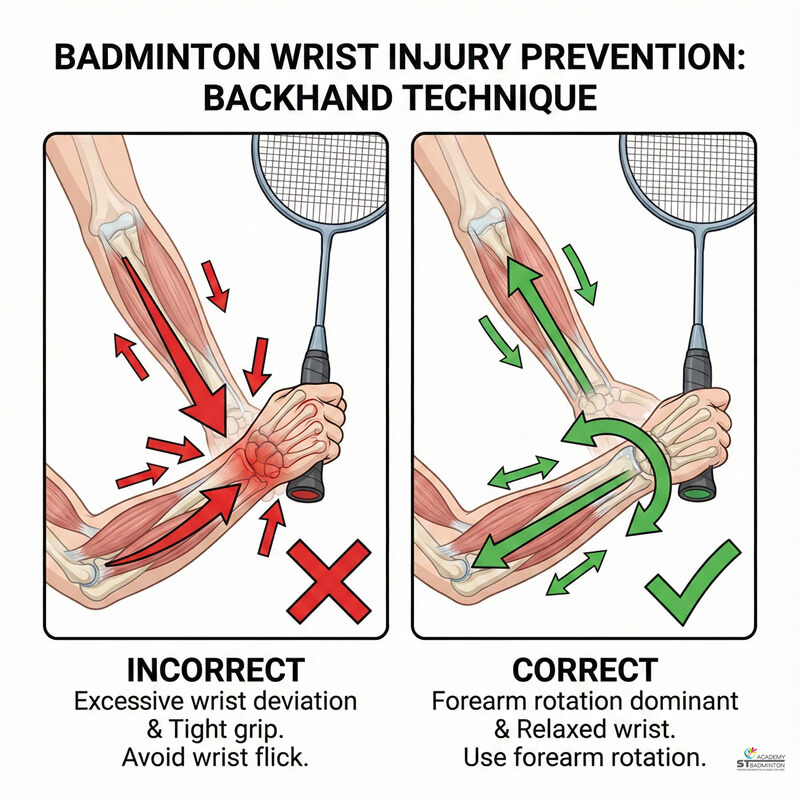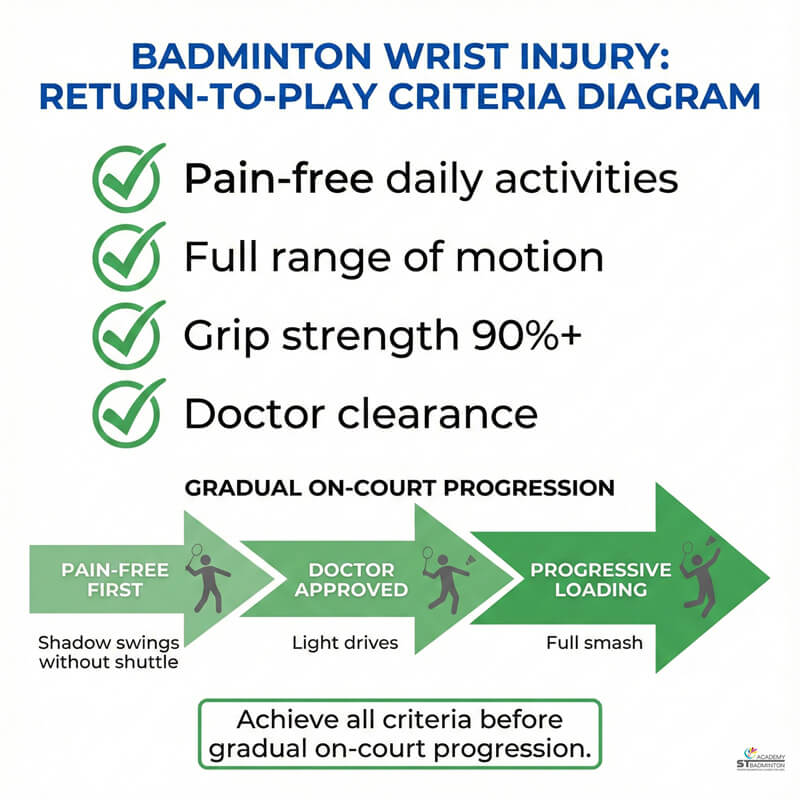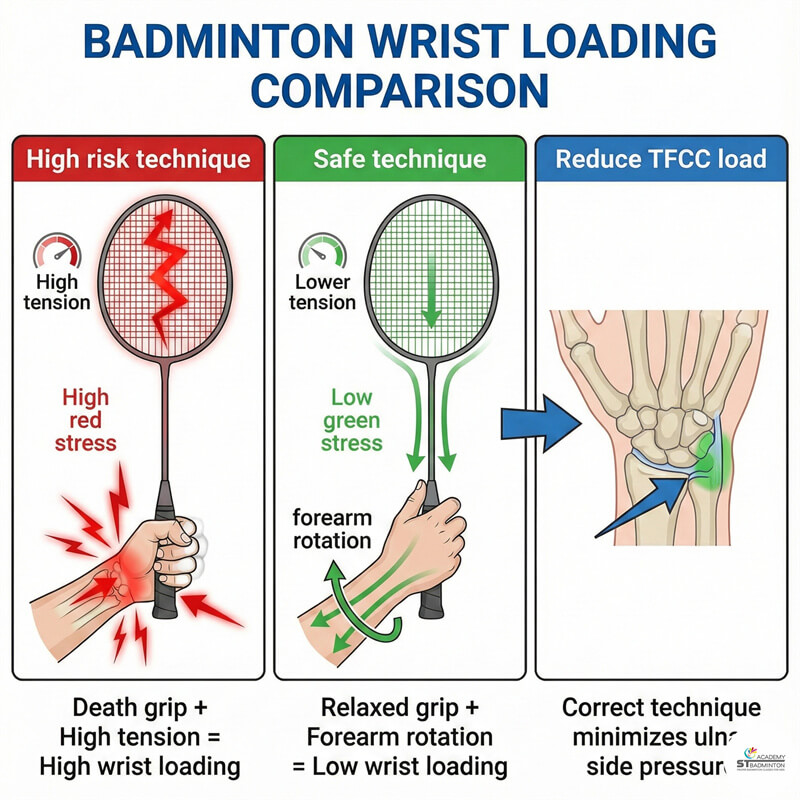TFCC Injury from Badminton – How to Fully Recover Safely (Malaysia)
After that, players often realize they need a proper plan. This guide explains what a TFCC injury is, why it causes ulnar side wrist pain in badminton, and how to approach recovery safely. Whether you play in Setapak, Wangsa Maju, Cheras, or anywhere in Kuala Lumpur, understanding this injury is key to returning to the court without long-term pain.
Disclaimer: This guide is for educational purposes only and does not replace medical advice. If you have wrist pain, please consult a doctor or physiotherapist.

What is it?
Understanding the TFCC Injury
The Triangular Fibrocartilage Complex (TFCC) is a small cushion structure on the ulnar side (little finger side) of your wrist. It acts as a stabilizer when you rotate your forearm or grip your racket tightly. In badminton, we constantly twist the wrist for net shots, smashes, and backhands.
When these movements are repetitive, forced, or done with poor technique, the TFCC can get irritated or torn. This is why players often feel a sharp pain on the outer wrist when turning a doorknob or doing a push-up. For players in Setapak and Gombak, understanding this anatomy helps explain why “playing through pain” usually makes it worse.

Signs & Symptoms
How Do I Know If I Have TFCC Injury?
The most common sign is ulnar-sided wrist pain (pinky side) that gets worse with rotation or weight-bearing. You might feel a “click” or “clunk” when moving your wrist. In badminton, you may notice your grip strength is weaker, or you feel sharp pain during backhand clears or smashes.
If your wrist hurts when you try to lift yourself out of a chair using your hands, or simply holding a heavy pan, these are warning signs. Do not self-diagnose; these symptoms overlap with other wrist issues. Please see a doctor or sports physiotherapist in Kuala Lumpur for a proper check-up and potentially an MRI scan.

Safe Recovery Steps
How to Recover & Return to Badminton
Recovery usually starts with rest and protection. Your doctor might suggest wearing a splint (like a WristWidget or brace) to unload the TFCC while it heals. During this acute phase, avoid heavy lifting or racket training.
Once the pain subsides, a physiotherapist will guide you through gradual strengthening exercises for the forearm and grip. Returning to badminton must be step-by-step: start with shadow swings, then light drives, and finally heavy smashes only when pain-free. Rushing back to full games at sports halls in Cheras or Ampang too early is the main reason for re-injury.

Prevention
Preventing TFCC Issues in Badminton
Prevention is better than cure. Correct grip technique is essential; holding the racket too tight restricts wrist movement and increases stress. Learning to use forearm rotation properly instead of just “flicking” the wrist helps unload the TFCC.
Managing your training load is also critical. Do not suddenly increase training from 2 hours to 10 hours a week. Equipment choice matters too; avoid extremely heavy-headed rackets or very high string tensions if you have a history of wrist pain. At ST Badminton Academy, we guide players in Setapak and Melati Utama on safe technique adjustments to protect their wrists long-term.

The Reality
Can I Play Badminton Again After TFCC Injury?
Yes, many players return to badminton successfully after TFCC injuries. However, “return” does not mean jumping straight back into competitive matches. It requires patience.
The timeline varies greatly depending on the severity of the tear. A minor strain might take a few weeks, while a tear requiring surgery could take months. The key is to listen to your body and your medical team. Returning with a stronger wrist, better technique, and a smarter training plan will not only prevent re-injury but often makes you a more disciplined player.

Common Mistakes
Why Players Get Re-injured
Many players return too soon because the pain “feels gone” during daily activities. However, badminton forces are much higher than holding a cup of coffee. Without rehabbing the TFCC to handle the specific load of a smash or backhand drive, the injury often flares up again.
Another mistake is ignoring the kinetic chain. Sometimes wrist pain comes from poor shoulder or elbow stability, forcing the wrist to do too much work. A good rehab program addresses the whole arm, not just the wrist.

Why Choose Us
Injury-Aware Coaching in Kuala Lumpur
At ST Badminton Academy Malaysia, we prioritize player longevity. Head coach Mr Eric Chuar understands the mechanics of badminton injuries. We help players adjust their technique to unload stressed areas like the TFCC.
We are not doctors, but we work with players to ensure their return-to-sport plan is followed on court. Whether you are in Setapak, Kepong, or Cheras, we provide a supportive environment where technique correction helps prevent future injuries.
FAQs: TFCC Injury & Badminton in Kuala Lumpur
Common questions from players in Setapak, Wangsa Maju and KL about wrist pain and recovery.
What are common signs of a TFCC injury from badminton?
The most common sign is pain on the ulnar side (little finger side) of the wrist, especially when rotating the forearm or doing weight-bearing activities like push-ups. In badminton, this often manifests as sharp pain during backhand strokes, smashes, or when gripping the racket tightly. Clicking sounds may also be present. If you have these symptoms, please see a doctor.
Can I still play badminton if I have TFCC wrist pain?
If you have ongoing pain on the little finger side of the wrist, especially with twisting, it is safer to reduce or stop badminton and see a doctor or physiotherapist first. Pushing through the pain often worsens the injury and delays healing. At ST Badminton Academy Malaysia in Setapak, Kuala Lumpur, we always ask players to solve wrist issues early instead of pushing through pain.
How long does TFCC injury recovery usually take for badminton players?
Recovery time varies greatly depending on the severity of the injury. A mild strain may take 4-6 weeks of rest and rehab, while a tear requiring surgery could take 3-6 months or longer. Every player is different. It is crucial to follow the timeline given by your medical professional in Kuala Lumpur rather than rushing back to the court.
When should I see a doctor or physiotherapist for ulnar wrist pain?
You should see a professional if the pain persists for more than a few days, if there is swelling, clicking, or instability, or if the pain prevents you from doing daily tasks like opening a door. Early diagnosis is key to faster recovery. There are many sports clinics in Cheras, Setapak, and Petaling Jaya that can assess wrist injuries properly.
What can I do to reduce the chance of TFCC problems when training?
Focus on proper grip technique; avoid “death-gripping” the racket. Ensure your forearm and wrist are properly warmed up before playing. Gradually increase training intensity rather than spiking it suddenly. Using equipment (racket/string tension) suitable for your level also helps reduce stress. Coaching guidance at ST Badminton Academy helps identify risky habits early.
Do I need an MRI to diagnose a TFCC tear?
Often, yes. While physical tests can suggest a TFCC issue, an MRI is usually the gold standard for confirming a tear and its severity. This decision should be made by an orthopedic specialist. Do not rely on Google diagnoses; get a professional scan if recommended by your doctor in Kuala Lumpur.
Can I use a wrist guard or support while playing?
Specific supports like the WristWidget or ulnar-sided braces can help unload the TFCC and reduce pain during daily activities or light play. However, a brace is not a cure. It should be used as part of a broader rehab plan guided by a physiotherapist. Do not use a brace just to ignore pain and keep playing hard.
Does changing racket grip size help with TFCC pain?
Sometimes. A grip that is too small or too large can force you to grip tighter than necessary, increasing forearm tension and wrist stress. Finding the correct grip size that allows a relaxed hold can help reduce the load on the wrist. Our coaches can advise on proper grip customization.
Is surgery always required for TFCC tears?
No. Many TFCC tears can heal or become asymptomatic with rest, splinting, and proper rehabilitation. Surgery is usually a last resort for unstable tears or when conservative treatment fails. Always try a structured rehab program with a physio first before considering surgery, unless advised otherwise by your specialist.
Safe Badminton Training in Kuala Lumpur in Action




The Path to Pain-Free Badminton
Returning to the court after a TFCC injury requires patience and discipline. By following medical advice and adjusting your training habits, you can play without pain.
| Factor | Ignoring Pain (The Mistake) | Smart Recovery (The Fix) SAFE |
|---|---|---|
| Pain Management | Playing through "clicks" and sharp pain. Taking painkillers to mask it. | Resting immediately. Seeing a doctor for diagnosis. Using ice/splint. |
| Training Load | Continuing full smashes and backhands. | Stopping racket work. Focusing on legs/core while wrist heals. |
| Return to Court | Jumping back into full games as soon as pain eases slightly. | Gradual return: shadow swings -> soft hits -> drives -> full play. |
| Equipment | Using heavy rackets and very high tension (28lbs+). | Using lighter rackets and lower tension (22-24lbs) to reduce vibration. |
| Technique | Forcing wrist flicks with poor form. | Learning proper forearm rotation to generate power safely. |
| Long Term Result | Chronic pain, surgery risk, quitting the sport. | Full recovery, stronger wrist, playing for years to come. |
Recover Safely with Expert Guidance in Kuala Lumpur
Don't let a TFCC injury end your badminton journey. With the right medical care and a coach who understands safe technique, you can return to the court stronger. ST Badminton Academy Malaysia in Setapak offers coaching that focuses on injury prevention and correct form. If you are recovering and want to restart safely, contact us today.




